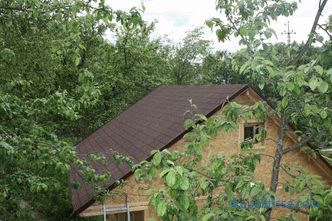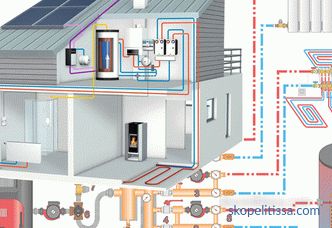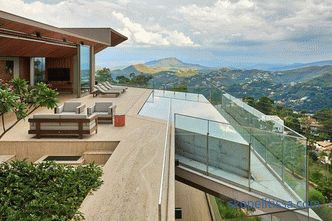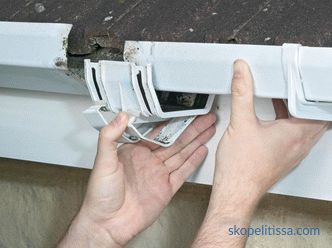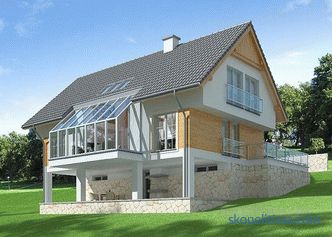Comfortable living conditions in a country cottage cannot be created without a high-quality heating system. It should be sufficiently efficient and economical so that during the heating period the living rooms are warm and the energy costs do not go too high. To achieve this, you need to choose the type of heating system, and then choose the most suitable option for connecting radiators in a private house.
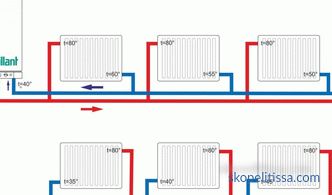
Types of heating systems
Heating systems in a private house can be:
-
air;
-
electric;
-
water.
Air system
This option functions without heat carrier. The air in the house is heated directly from the heating devices - stoves or convectors. This system does not use radiators. Air heating is convenient for heating compact country houses. For large cottages, it is used very rarely.
Electrical System
In such a system, heat is transferred through current conductors. According to this principle, electric underfloor heating works. Heating with an electrical system can be quite convenient. But its arrangement requires increased attention to safety rules, and in the process of exploitation it costs a lot to the owners of the house.
Water system
A type of heating system in which heat is transferred by means of water (sometimes steam) as heat carrier. The coolant flows from the heating device through pipes into the radiators of heating. This option is considered the most convenient and practical. Most often in country houses heating is settled in this way.
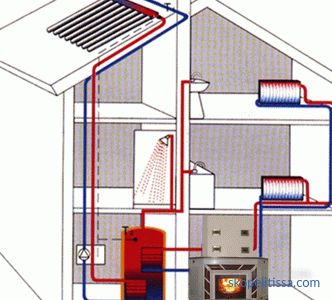
Types of heating boilers
The central element of the heating system is the boiler - heating device, in which the coolant reaches the desired temperature. The connection scheme of heating in a private house depends largely on what kind of boiler it is used.
By appointment, boilers are divided into two-circuit and single-circuit. The first option is equipment designed for both heating and water heating. Single-boiler only heats the coolant for heating. By the method of installation, they are divided into floor and wall.
The boilers also differ in the type of fuel used to heat the coolant. There are boilers of the following types:
-
gas;
-
electric;
-
solid;
-
fuel oil;
-
combined.
Coal, firewood, less often peat and other solid combustible materials are used to operate solid fuel boilers. As a liquid fuel for boilers of the corresponding type, diesel or used oils are used.
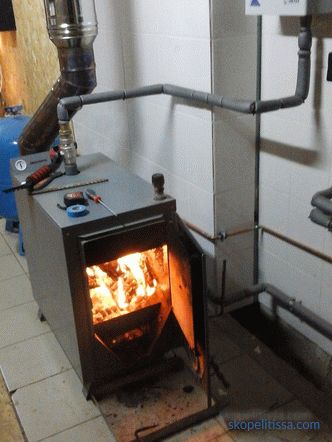
Most country cottages are heated by gas boilers. In non-gasified areas, electric heating is often used. Solid fuel and liquid fuel boilers are completely independent of the communication networks. The first option is more attractive because it requires traditional firewood and coal, rather than hazardous combustible liquids.
The most prudent homeowners install combined boilers in their homes to work on different types of fuel. For example, you can install electric boiler, supplemented with a combustion chamber for solid fuel in order to switch to wood heating in the event of damage to the power grid.
Dual-circuit boilers that provide housing with warm and warm water are primarily gas appliances. They are universal, as they relieve homeowners of the need to buy and install a water heater separately.
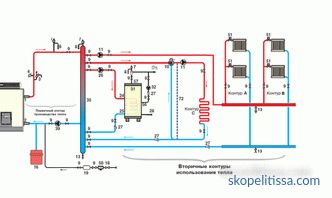
On our site you can find contacts of construction companies that offer a house insulation service. Directly to communicate with representatives, you can visit the exhibition of houses "Low-rise Country".
Device of a heating radiator
A heating radiator consists of several heat exchange sections. The more sections, the higher the battery capacity, respectively. There are such models of radiators that can be “re-grown” with new sections, if necessary, already in use.
Through all sections there is one collector in the upper part and one in the lower one. In each section there is a vertical channel connecting the upper and lower manifold. This applies to all sections, including the extreme. Therefore, the radiator has 4 outputs, but only two of them are used. One is connected to the coolant supply pipe, and the second serves to drain the cooled water back to the boiler. Unused outputs are closed with plugs.That's the way most radiators work.
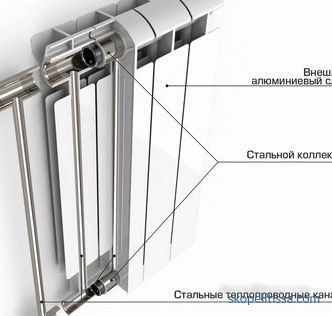
It might be interesting! In the article on the following link read about heating radiators for a private house.
Types of piping system
In the scheme of the heating system, the mutual position of the input of the coolant and the output of the "return" is of fundamental importance. It depends on the direction of the coolant and on the type of pipe system.
Single pipe system
This is a simplified version of the arrangement of heating in the cottage. This option is quite economical, as it requires fewer pipes for wiring and is performed with less labor for installation work. The system is a chain of radiators connected by a single pipe. The heat carrier heated in the boiler flows in turn into each radiator, flowing from one to the other. That is, the "return" from one battery becomes the supply for the next, and so on.
The single pipe connection scheme of heating radiators in a private house has one major drawback - with it, the radiators do not heat up evenly. The first radiator will always be the hottest, and then the temperature from the battery to the battery will gradually decrease. Therefore, it is impossible to maintain the same temperature in all rooms with one-pipe heating.
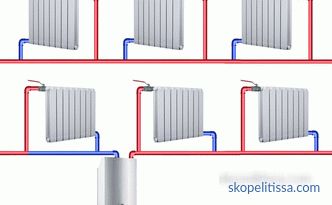
With certain features of the layout, a one-pipe system may be quite suitable. So, if in a small house the chain of radiators begins with living rooms and ends with technical premises, this option may be optimal. But in spacious cottages it is better to install double-pipe heating.
Two-pipe system
More expensive in arrangement, but simple and convenient in operation option. In this system, two pipe lines operate simultaneously. The first supplies hot water to each battery. That is, there is one pipe with a call at each radiator. The coolant, before getting into the radiator, regardless of its location in the circuit, does not enter adjacent radiators, but goes directly. The second pipe collects the return pipe from all radiators and delivers it to the heating collector.
The advantages of the bottom wiring type are that almost all temperatures are reached at all heat exchange points. Such a system is better adjusted and provides uniform heating of the entire building.
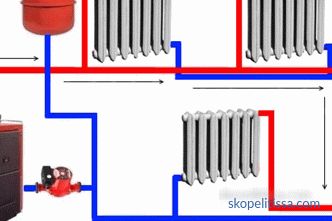
Beam (collector) system
The collector scheme is a two-pipe connection option, but with more complex layout. It is used in cases when you need to hide the pipe, for example under the floor covering. In this case, two collectors are equipped - under the supply and under the return, and from each radiator one pipe is pulled into the first collector, and another one into the second.
In some wiring diagrams, two types of systems are used. The whole house can be heated according to the two-pipe principle, but for a separate section, for example, a veranda or a large living room, a bunch of several radiators are used according to the one-pipe principle. When developing a two-pipe scheme for connecting radiators in a private house, the main thing is not to get confused in the supply and return manifolds.
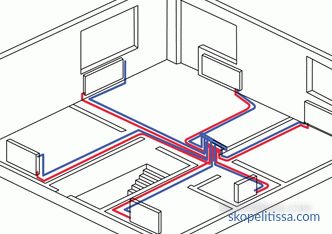
It can be interesting! In the article on the following link read about the connection diagram of the hydroaccumulator to the pump and the water supply system.
The scheme of connecting radiators to the heating system
The heat transfer medium moves through the pipes and channels of the batteries due to two factors. The first is the desire of the fluid to fill the voids. In the absence of air traffic jams, the natural dynamic pressure of the coolant is created. The second factor is the movement of flows of different temperatures. Hot water tends upward, displacing cold water into the lower stream.
Diagonal top connection
The diagonal connection of top-flow radiators allows you to equip the most efficient space heating. Hot water is supplied to the upper inlet, inside it spreads through the sections, and when it cools, it goes down, then it is forced out into the lower entrance to the return manifold located on the other side of the radiator.
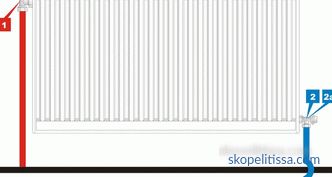
Two-way bottom connection
Supply is carried out to the bottom entrance from one side, and the return coming out of the bottom entrance on the other side of the battery. The effectiveness in this case is lower than in the previous version. But this connection allows you to hide the pipe.
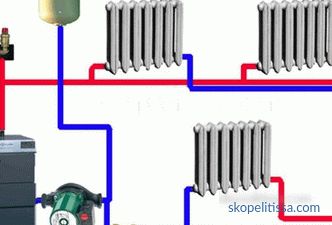
It can be interesting! In the article on the following link read about the system heating in a private house.
One-way lower top connection
Used mainly in high-rise buildings.In the cottages of 2 or 3 floors with one-pipe heating is also sometimes used. The difference between the lower and upper connection is that in the first case, hot water is supplied to the lower inlet, and is discharged under pressure through the upper inlet, and in the second case, the opposite happens. In both cases, the plant and the coolant outlet are located on one side. It is worth noting that, of all the existing options, one-way bottom connection is the most inefficient.
What type of radiator connection system to choose
Other options
Theoretically, you can apply another diagonal connection from the bottom or two-way connection with filing on top. These two options will also work if done correctly. However, the functioning of the system will be very difficult due to the intersection of the flows. Therefore, it is better not to experiment and to take as a basis a diagonal top connection or a two-side bottom connection.
Location of radiators
For high-quality heating of a cottage, it is necessary not only to choose the heating scheme correctly, but also to correctly position the batteries in the rooms. Installation of radiators in a private house is carried out on the basis of calculations made by specialists. The number of radiators and sections for each radiator is determined taking into account various factors:
-
room volume;
-
building heat loss level;
-
radiator inset scheme;
-
at what height the batteries will be installed, and much more.
How to calculate the number of radiators
Usually, radiators are placed under the windows. This creates a barrier to the cold air flow from the window. In addition, the air coming from the window opening is “dried” by heat from the radiator, as a result, no condensate is collected on the surfaces in the room. The battery should be a little bit already window, and it should be located in the center relative to the window opening.
The radiator should not adjoin its upper part to the sill, since this complicates the process of heat distribution. From the floor to the bottom of the battery should be about 100 mm. A higher position will cause the air directly above the floor to warm up badly. If you install radiators too low, it will be difficult to remove accumulated dust under them.
When planning the installation of batteries, it is necessary to take into account the peculiarities of the wall. Modern batteries are not very heavy, but in some cases, the characteristics of the wall require reinforcement of the surface on which the bracket for heating elements will be mounted.
Installation of heating radiators
On our website you can find contacts of construction companies that offer the installation of water supply, sewage and heating . Directly to communicate with representatives, you can visit the exhibition of houses "Low-rise Country".
Conclusion
The process of calculating, designing and installing a heating system can only be trusted by qualified specialists. But the simplest rules for connecting radiators should be known to every homeowner. The effective principle of connecting and arranging heating equipment is a guarantee that a favorable and comfortable microclimate will always reign in the house.
